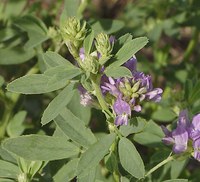Make a plan for late-season alfalfa management
(Click the image below to view a high-resolution image that can be downloaded)
Fall is an important time to consider what to do with regrowth for alfalfa and other perennial forage plants, according to North Dakota State University Extension specialists.
As days grow shorter, alfalfa will begin to translocate sugars from leaves to the roots and crowns to be stored as carbohydrates, says James Rogers, forage crops production specialist for NDSU Extension. The plant will use these stored carbohydrates to initiate spring growth. This storage process will continue as long as the plant is actively growing and ends at the first killing freeze (24 degrees Fahrenheit). Once alfalfa has stored its carbohydrate reserves, harvesting or grazing alfalfa can deplete them, preventing the crop from replenishing those reserves before the end of the growing season.
“Gauging that last alfalfa harvest timing can be tricky,” Rogers says. “Ideally, alfalfa needs 500 growing degree days or five to six weeks before a killing frost to allow enough time for carbohydrate storage to occur. Using North Dakota Agricultural Weather Network (NDAWN) data and calculating growing degree days for alfalfa, the last harvest for alfalfa would be sometime the first week of September.”
The exact timing for a final harvest or grazing can vary. A late harvest is fine for an older alfalfa stand that will come out of rotation the following year. Well-established alfalfa stands that are four years old or less can tolerate a later harvest than older stands. The alfalfa variety and winter survival rating can also influence the timing of a final harvest. Winter severity is an unpredictable factor. Good snow cover and slow spring melts are better for alfalfa winter survival following a late-season harvest than an open, warm winter.
Rogers describes two strategies for late-season alfalfa management:
- The first option is to complete harvest or grazing by early September to allow for carbohydrate reserves to accumulate. Any regrowth that occurs will carry into and through winter.
- The second option is to delay harvest or grazing long enough that carbohydrate reserves are developed but temperatures are low enough that any regrowth that occurs will not severely deplete carbohydrate reserves before a killing freeze. Little alfalfa regrowth will occur once temperatures consistently average 41 degrees Fahrenheit, generally in mid-October.
For either strategy, Rogers recommends farmers and ranchers leave a 4-to-6-inch residual height for crown protection and snow catch. A late-season hay cutting can be good quality, but curing can be an issue due to cooler temperatures and higher humidity.
Grazing late-season alfalfa can extend the grazing season with high-quality forage, but Rogers advises using caution when grazing alfalfa due to bloat risk. Bloat risk increases with frost-damaged alfalfa, which causes plant cells to burst, increasing protein solubility. Bloat risk is the highest following a killing freeze. Avoid grazing alfalfa for at least 10 days following a killing freeze to allow alfalfa time to dry down and completely die back.
“Alfalfa is a wonderful perennial forage crop that can have a long stand life in the Dakotas. Allowing alfalfa to build and preserve its carbohydrate root reserves before winter will help maintain and extend its lifespan,” Rogers says.
NDSU Agriculture Communication – Aug. 30, 2024
Source: James Rogers, 701-857-7682, james.rogers.1@ndsu.edu
Editor: Elizabeth Cronin, 701-231-7006, elizabeth.cronin@ndsu.edu


